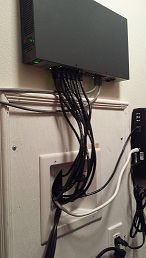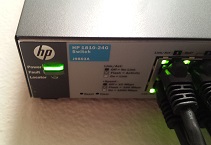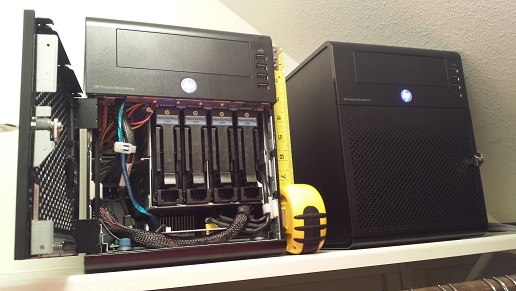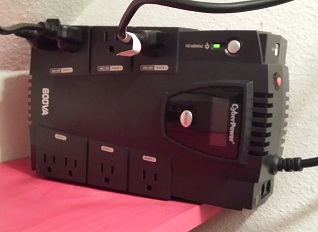
|
|
Systems Administration
Design of home IT infrastructure
Network
HP 1810-24G Switch. It's a little overkill, but I wasn't able to find a desirable 16 port switch. With the swtich I was able make all the ethernet ports in the home live on top of servicing the server infrastructure I speak about below.

|

|
Server Infrastructure

Server One - HP ProLiant N40L MicroServer Server System AMD Turion II Neo N40L 1.5GHz 2-Core
- 10.5" x 8.3" x 10.2"
- 8GB (2 x 4GB) DDR3 RAM
- 1 x 250GB SATA WD for the OS (FreeBSD 9)
- 4 x 3000GB SATA WD RAIDED with zfs
- NFS using Samba
- Apache/PHP/MySQL
- Squeezebox server
- IP: 192.168.1.10
- Root run cron entry: Backup Script /root/scripts/rsync-backup.sh
Backup script uses rsync to keep the Douments/Pictures of users in sync with another copy on a remote server. Any additions/deletes/modifications of any directories/files within these folders are duplicated on the remote server it backups up to once a week. Then emails me a report of what occurred. Here is a sample:
2015/03/22 10:00:04 [1669] building file list 2015/03/22 10:00:04 [1669] <f+++++++++ pictures/2419Roufa/FrontDoor/DSC_0018.JPG 2015/03/22 10:00:23 [1721] <f+++++++++ Documents/1038 N.E Van Loon Terr/mortgage/payments/march-2014.pdf 2015/03/22 10:00:26 [1725] *deleting www/www.allengibbard.com/wordpress/wp-includes/pomo/

All content is stored on Server 1. Pictures, Music, Documents, Videos, development websites, etc. for each user account on the server. House hold account holders can mv/cp content from their phone, tablet, or desktop by way of NFS share. As you can see there is more than enough space packed in that small server to last for a long time. Using ZFS for redundancy. I can lose one of the 4 Hard-Drives and should be able to rebuild all the missing data on a new disk. The backup script copies all user's "[dD]ocument", [pP]ictures" folders which reside in thier home directory. Files not written to these directories are not backed up.
Servers 2 Hardware - HP ProLiant N40L MicroServer Server System AMD Turion II Neo N40L 1.5GHz 2-Core
- 10.5" x 8.3" x 10.2"
- 8GB (2 x 4GB) DDR3 RAM
- 1 x 250GB SATA WD for the OS (ESXi 5.5)
- 4 x 1000GB SATA WD
- IP: 192.168.1.20
- VSphere was installed on my local windows laptop with the free License so I can manage the VMs on the ESXi server
Created base image to use as a template for my VMs
- Download CentOS netinstall iso
- Created new VM called TemplateServer using that iso, and completed the install.
- Updated all the packages installed (yum check-update, yum clean all, yum update).
Cloning VM in vSphere without vcenter you tube
- In the ESXi interface, right click go to properties, select "storage".
- Create folder under the parent of the new VM you want to create. Like "appServer".
- In the same window go into the TemplateServer folder and right click on the .vmx and the vmkd files and select "copy".
- Click on the newly created VM folder (i.e. appServer) and paste what was copied into that folder. It takes a bit of time copy.
- After, right click on the .vmx file and select "Add to Inventory", and use a name to describe the VM. I used the same name "appServer".
- The VM should then appear in the left pane with any of the other VMs you may already have.
- Start the VM.
- Next, you need to address the network configuration. by doing the following:
- Delete /etc/udev/rules.d/70-persistent-net.rules
- Comment out the HWADDR= in /etc/sysconfig/networ-scripts/ifcfg-eth0
- Reboot.
VMs
Backup - This server has about 900GB of space, and excepts the data rsync'ed from the other HP NL40 server running FreeBSD. There is a cron job on the FreeBSD server which runs every Sunday at 10am. It emails me a detailed report on the syncs.
appServer - This Server runs Tomcat and was allocated 2GB. I use this server to practice developing applications.
Services - THis server has other services that the household uses, but is also for my personal develop. So far I'm running a DNS, LDAP, httpd, and squeezbox server on this one VM.
Notes- Remote mount share for user to the samba server from the services VM. Check /etc/fstab
- iptable rules to allow access to httpd and squeezebox service (ports 80/443/9000)
TemplateImage - is just the VM I use to create all the other VM. Being the infrastructure is so samll on these servers, I'm really limited to about 4 or 5 VMs. This VM stays off until I wish to create a new VM or upgrade an existing one. I will start this VM up, and conduct any patching or upgrades. Then use this as a template to create an updated/current VM.
Added another disk to the "Backup" VM using this documentation
Uninterruptible Power Supply (UPS)

| Powered By Source H | Last Modified: 05.14.25 | |